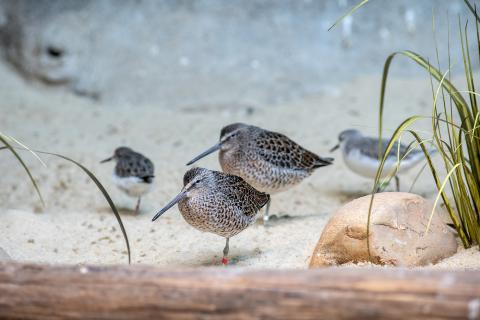Physical Description
Most of their coat is rusty red in color; however, fur on the forehead, stomach, tail, and inside of limbs is black and there is a white patch on the back of the neck.
Size
A small primate species native only to Madagascar, red ruffed lemurs live only in one protected area and are critically endangered.
Native Habitat
Red ruffed lemurs are restricted to the northeastern part of Madagascar; they can be found in the forests of the Masoala Peninsula near Maroantsetra. They also have been spotted to the east of the Antainambalana River, which divides their range from the range of black and white-ruffed lemurs. Red ruffed lemurs live in deciduous forests.
Lifespan
Red ruffed lemurs have a life span of 15 to 20 years in the wild, sometimes longer in human care.
Communication
Red ruffed lemurs warn other group members about predators through a number of alarm calls, which appear to vary depending on the location of the predator. Even though they do not encounter venomous snakes in the wild, red ruffed lemurs at the Duke Primate Center developed a venomous snake call in the presence of copperhead snakes. They can also understand the alarm calls of black-and-white ruffed lemurs, which come from a different part of Madagascar.
Food/Eating Habits
Red ruffed lemurs are entirely vegetarian. They eat some leaves, seeds, and nectar, but most of their diet consists of fruit. At the Smithsonian's National Zoo, they eat two types of primate biscuit, corn, sweet potato, bell pepper, carrot and celery.
Reproduction and Development
Breeding occurs from May until July. After a 90 to 120 day gestation period, females usually give birth to three young (although they can have up to six young in one litter). Ruffed lemurs are one of only a few primates that have litters of offspring, and females have six nipples so that they can nurse all of their young simultaneously. Young stay in a crude nest while adults search for food, unlike most primates who carry their offspring with them.
Conservation Efforts
These primates are listed as critically endangered due to deforestation, hunting and trapping. Red ruffed lemurs are present in Masoala National Park but the park was, unfortunately, subject to a surge of illegal logging following political events in Madagascar in 2009.
Increased regulation, management and oversight to reduce illegal logging and hunting is needed. A reserve population exists in human care in the U.S. and Europe (590 individuals as of 2009) but genetic diversity is a limitation.
Help this Species
- Reduce, reuse and recycle — in that order! Cut back on single-use goods, and find creative ways to reuse products at the end of their life cycle. Choose recycling over trash when possible.
- Be a smart consumer. Choose products made with sustainable ingredients, such as Smithsonian certified Bird Friendly coffees, which support farmers striving to limit their impact on wildlife and habitat.
- Share the story of this animal with others. Simply raising awareness about this species can contribute to its overall protection.
Meet the Animals
Animal News

Leaf-tailed Gecko Treated for Skin Cancer With Chemotherapy


